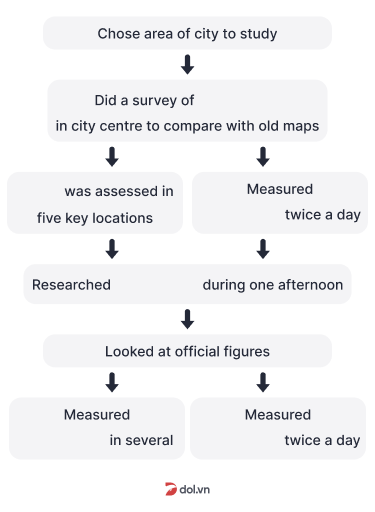IELTS Trainer - Listening Test 3 With Practice Test, Answers And Explanation
Luyện tập đề IELTS Online Test IELTS Trainer - Listening Test 3 được lấy từ cuốn sách IELTS Trainer với trải nghiệm thi IELTS trên máy và giải thích đáp án chi tiết bằng Linearthinking, kèm answer key và list từ vựng IELTS cần học trong bài đọc.
Section
👂️ Bài nghe section 1
Club started in 1957
prize recently won by
section1
usually performs
plays2
next auditions will be on Tuesday,
3
help is needed with
and …4
rehearsals take place in the
hall5
nearest car park for rehearsals is in Ashburton Road opposite the
6
Annual membership fee is £
7
Extra payment for
8
Secretary’s name is Sarah
9
Secretary’s phone number is
10
❓ Tapescript section 1
🔥 Đáp án & giải thích section 1
Giải thích chi tiết
 Mình cần nghe xem giải thưởng gần đây nhất thuộc về ai
Mình cần nghe xem giải thưởng gần đây nhất thuộc về ai
=> Đáp án sẽ có sau '' ... the other day of some of your members being presented with a prize.''
 Mình nghe được là '' Yes, the youth section did very well in a competition and won £100 ...''
Mình nghe được là '' Yes, the youth section did very well in a competition and won £100 ...''
=> Youth Section dành được giải trong cuộc thi.
=> Đáp án là Youth 
Section
👂️ Bài nghe section 2
❓ Tapescript section 2
🔥 Đáp án & giải thích section 2
Giải thích chi tiết
 Mình cần biết công việc của Forward-thinking là gì.
Mình cần biết công việc của Forward-thinking là gì.
=> Đáp án sẽ có sau " This week I'm going to talk about Forward thinking and their plans for the Colville Centre"
 Jasmine giải thích chi tiết hơn là ''The idea behind Forward thinking is to use the arts to promote wellbeing. The charity develops projects for people with special needs and health problems and also delivers training to healthcare professionals in using the arts, as well as supplying them with information and advice.''
Jasmine giải thích chi tiết hơn là ''The idea behind Forward thinking is to use the arts to promote wellbeing. The charity develops projects for people with special needs and health problems and also delivers training to healthcare professionals in using the arts, as well as supplying them with information and advice.''
=> Có ba công việc chính: 1) phát triển các dự án về hội họa cho người khiếm khuyết hoặc người bệnh
2) tổ chức các khóa đào tạo về hội họa cho chuyên gia y tế
3) cung cấp thông tin và lời khuyên.
=> Nói chung, công việc của họ là khuyến khích việc sử dụng hội họa trong lĩnh vực chăm sóc sức khỏe.
=> Đáp án là C 
Section
👂️ Bài nghe section 3

❓ Tapescript section 3
🔥 Đáp án & giải thích section 3
Giải thích chi tiết
 Đối tượng là survey (Did a survey of .... in city centre to compare with old maps"
Đối tượng là survey (Did a survey of .... in city centre to compare with old maps"
=> Đáp án sẽ có sau '' ... at how it has been developed by doing a survey.''
 Sau đó, '' We did that by walking round and dividing the area into different categories such as residential, commercIal and Industrial so we could record land use.''
Sau đó, '' We did that by walking round and dividing the area into different categories such as residential, commercIal and Industrial so we could record land use.''
=> Cách khảo sát là họ chia vùng thành các nhóm khác nhau, bao gồm residential (khu dân cư), commercial (khu thương mại) và industrial (khu công nghiệp), để record mục đích sử dụng đất (land use)
=> Đáp án là C 
Section
👂️ Bài nghe section 4
Pottery used
clay36
saved money on
37
needed two firings in the Kiln to be
38
fragility led to high
during manufacturing39
more emotive but better
made from a
of clay and flint40
❓ Tapescript section 4
🔥 Đáp án & giải thích section 4
Giải thích chi tiết
 Đáp án cần tìm liên quan tới thế kỷ 18 (In the eighteenth century, the .... still determined how most people made a living)
Đáp án cần tìm liên quan tới thế kỷ 18 (In the eighteenth century, the .... still determined how most people made a living)
=> Đáp án sẽ có sau ''and we need to go back, mainly to the eighteenth century ...''
 Mình nghe được là ''the majority of the population, ...., were dependent.... not on the geographical location of where they lived, but on the physical characteristics of the actual land they lived on.''
Mình nghe được là ''the majority of the population, ...., were dependent.... not on the geographical location of where they lived, but on the physical characteristics of the actual land they lived on.''
=> phần lớn dân số không phụ thuộc vào địa điểm họ sống mà phụ thuộc vào đất đai của họ
=> Đáp án là land 


